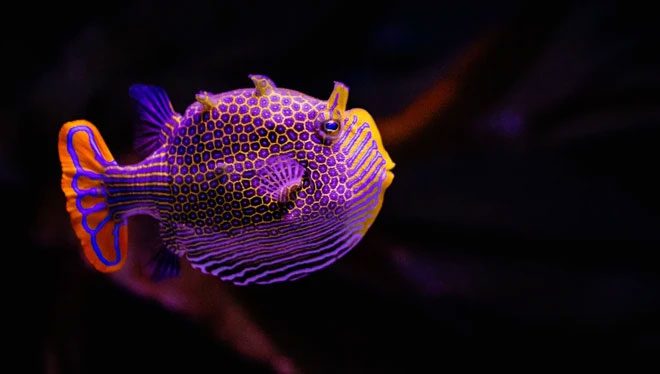American scientists have recently published a study reinforcing the hypothesis of mathematician Alan Turing, suggesting that the patterns on animal bodies are not random but are created by a diffusion process.
Boxfish exhibit striking patterns with hexagonal spots and “striped” designs so sharp that engineers at the University of Colorado Boulder were left “puzzled” about how they achieve such a unique appearance.

A boxfish at the Birch Aquarium in San Diego, California. (Source: CNN/Screenshot).
More than 70 years ago, renowned mathematician Alan Turing – the father of modern computing – proposed a hypothesis that animals acquire patterns on their bodies through the production of chemicals that diffuse through skin tissue, similar to how cream swirls in coffee.
The chemicals interact with each other while other agents suppress their activity, leading to the formation of patterns. However, Turing’s theory did not explain how these “patterns” are expressed “clearly” in species like boxfish.
A team of engineers at the University of Colorado Boulder explored how diffusion mechanisms could create such sharp patterns, in a study published on Wednesday in the journal *Science Advances*.
Diffusion describes the movement of suspended molecules in a liquid in response to a concentration gradient (the difference in concentration of a substance between two areas), causing small particles – in this case, pigment cells – to aggregate and coalesce.
When scientists calculated Turing’s equation – modified to include this process – the simulations they created showed that the paths of the molecules always produced sharp outlines, unlike the indistinct blurs generated solely by Turing’s theory.
“What we were really curious about is if it is diffusion, then the patterns wouldn’t be sharp… the colors wouldn’t be so vivid. So what gives these patterns their sharpness? – That’s where the diffusion method comes into play,” said Ankur Gupta, Assistant Professor of Chemical and Biological Engineering at the University of Colorado Boulder.
According to a press release about the study, the engineers’ findings indicate that through the diffusion of chemical agents, pigment cells are also pulled along their “trajectory” during the diffusion process, creating spots and stripes with much sharper outlines.
Gupta expressed hope that these findings would encourage deeper research into the genetic diffusion related to embryonic and tumor formation, as well as camouflage capabilities and biological processes in other species.
“The idea of sharpening the ‘interfaces’ is a good one and certainly important for biological function,” said Dr. Andrew Krause, Assistant Professor of Applied Mathematics at Durham University in the United Kingdom, who has studied Turing’s theory, in an email.
“Mathematical ideas like diffusion often lead to ‘smooth’ or continuous surfaces, while most boundaries in biological tissues (e.g., the boundaries between organs in your body) are relatively ‘rigid’… At least it is a viable way to sharpen gene expression regions,” Krause, who was not involved in the study, stated.
Other possibilities to refine Turing’s theory
Turing’s hypothesis first appeared in 1952 in a paper he wrote titled The Chemical Basis of Morphogenesis.
According to his theory, patterns on animal bodies are not random but are a systematic diffusion of chemical reactions producing spots – on a leopard, or stripes on a tiger, as per the University of Warwick.

According to Turing’s theory, patterns on animal bodies are not random but result from a diffusion process. (Source: PTI).
Jeremy Green, Professor of Developmental Biology at King’s College London, stated that while the diffusion method is a proposed change to reinforce Turing’s theory based on recent research, there might also be other viable solutions.
Green, who was not involved in the study, noted in an email: “Cells are extremely adhesive and would find it very difficult to move by diffusion.”
“Cell movement to sharpen a Turing pattern (essentially any boundary) is not a new idea and can occur not only through chemotaxis (active cell movement) but also through other mechanisms.”
Green believes this research could potentially impact future modeling and experimentation but acknowledges that there are still gaps in Turing’s theory that remain unexplored.
Green is a co-author of a study published in February 2012 that found evidence supporting Turing’s theory regarding patterns on the palates of mice.
“We considered other possibilities in our paper and acknowledged that processes like chemotaxis, i.e., cell movement, are all ‘present’,” Gupta stated in an email.
“We do not intend to assert that diffusion is the only mechanism, but rather that this mechanism has a ‘presence’ and has been underestimated. Combining diffusion methods will help improve the reliability of such hypotheses.”


















































